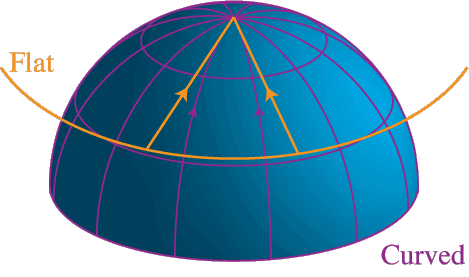
We've now seen how the microwave background can probe the origins of structure in the universe. The microwave background can also help us learn about its fate. Einstein told us that matter curves space. The more matter, the more space is curved.
What does this mean? We'll we're all familiar with one example of curvature -- the curvature of the surface of the earth.
Einstein came to the revelation that the familiar force we call gravity is no more than the curvature of space-time. This curvature is created by matter itself.
We do not yet know if our universe is spatially curved in a global sense. Just like the Columbus, we need someone to navigate a large fraction of the globe to decide its curvature. The distances are so large that we ourselves can't do that, but microwave background photons can.
In practice, the curvature is measured by the size of the spots in the microwave background maps. The larger the curvature the smaller the physical scale of the spots.
We can see this easily by thinking about the globe again.

In a curved space, the light bends as it travels and acts like it is going through a lens. In a (positively) curved universe, a small object appears larger. If we know the actual size of an object, like a spot in the microwave backgroun temperature due to sound waves, the size it appears lensed on the sky tells us the curvature of the universe.
The curvature decides the fate of the universe. What is curving space and lensing light is the matter itself. The more mass the universe has the greater its curvature. If the universe has enough mass, gravitational attraction can halt the expansion and cause the universe to recollapse.
By measuring the curvature of the universe in the size of spots in the microwave background temperature maps, we determine the ultimate fate of the universe.
These are but two examples of the many things the microwave background can tell us about the origin, evolution and fate of the universe.